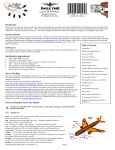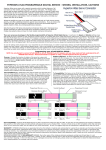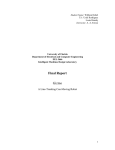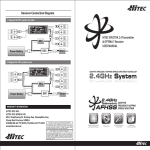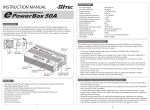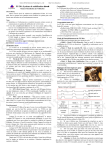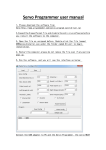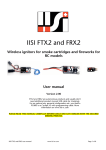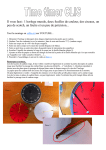Download HITEC DIGITAL SERVO PROGRAM MODE TEST
Transcript
- Select Sweep on the menu and click the START button. The servo will then move from end point to end point within its travel limits. - Use the slide bar next to the START button to adjust the servo’s travel speed. Automatic Step Position Test A servo will automatically travel from end point to end point using a slow step movement using this function. USB 2.0 - Select Step and click the START button. Your servo will start moving from end point to end point in a series of small “steps”. - Use the slide bar next to START button to adjust the servo’s travel speed. HITEC Digital Servo FAIL SAFE Position Test Introduction Congratulations on your purchase of the PC interface, HPP-21 HITEC digital servo programmer and “all brand” servo tester. Please read this manual before installing the software and using your new HPP-21. This feature will only test the user programmed FAIL SAFE point of HITEC digital servos. The FAIL SAFE point must be set by the user in the programming section under section 5, Center, End, and FAIL SAFE Point. - By clicking the ‘START’ button, the servo will travel to the preset FAIL SAFE position. The HPP-21 will allow the user to easily check any servo brand’s servo performance by using servo test functions and set most of the programmable parameters of all HITEC digital servo types as noted in the following statement; The HPP-21 will program the following features of these HITEC digital servos: - All HS-7XXX G2 servos: Fully programmable, including OLP Rate(Overload Protection Rate), and High Resolution adjustment function - Some HS-5XXX type servos: Fully programmable Feather and Micro Digital servos, including OLP Rate; Excluding High Resolution adjustment function (HS-5055, 5056, 5065, 5082, 5085) - Other HS-5XXX type servos: All features are programmable except OLP Rate and High Resolution adjustment functions NOTE: All HITEC gyro and analog servos are NOT programmable. NOTE: As noted above, you must have turned on the FAIL SAFE Mode and preset the FAIL SAFE position in the PROGRAMMING MODE to make this function work properly. If the FAIL SAFE Mode is selected “OFF”, the servo will stop and hold its last position which indicates the servo is in HOLD mode. HITEC DIGITAL SERVO PROGRAM MODE Package Contents Contents - One HPP-21 interface device - One User’s Manual The latest version of the software for the HPP-21 is available on the HITEC Website at (www.hitecrcd.com) Required Optional Parts (Sold Separately) - One Universal 5 pin mini-USB Cable for PC connection (less then 3ft. recommended). Available at most office supply sores - One 4.8V or 6V “receiver” battery*. *The HPP-21 requires an external power source in order to test/program a servo. HITEC recommends a standard 4.8V receiver battery, however a 6V pack may be used for servos rated at 6V. WARNING: Be sure to use a fully-charged battery to prevent any data loss or damage during the programming process The following functions can be programmed into most HITEC Digital servos using the HPP-21 Programmer; 1. FAIL SAFE, On or Off 2. Direction of Rotation 3. Resolution Setup (G2 HITEC Servos Only) 4. Travel Speed 5. Center, End, and FAIL SAFE Point 6. Dead Band Width 7. OLP Rate (Overload Protection Rate, G2 HITEC Servos Only) 8. “Save and Open” File Options 9. Reset Servo to Factory Default Program NOTE - To program a servo, be sure the HPP-21 is interfaced with your PC using a USB cable, the blue light is on, a battery is plugged into the “BATT” slot and a HITEC Digital Servo is plugged into the S1 or S2 slot. Basic Set–Up Instructions 1. Download and install the HPP-21 program software from www.hitecrcd.com. The HPP-21 software is compatible with Windows XP and VISTA. 2. Use the appropriate USB Cable (sold separately) to plug the HPP-21 into your PC. 3. Start the HPP-21 software from your PC. 4. Plug an appropriate receiver battery pack (4.8V 4 cell or 6V 5 cell battery) into the HPP-21 ‘Batt’ slot. 5. A servo must be plugged into slot S1 or S2 in order to program or to test. The HPP-21 supports two slots for servo testing, however it will only program one servo at a time using either slot S1 or S2. Precautions and Warnings a. DO NOT disconnect the HPP-21 until programming is completed. b. Disconnect the interface cable if an error occurs during the programming process. Restart the PC before reconnecting the cable. c. Use only a recommended power supply (4.8V, or 6V battery pack). NOTE: Some servos require 4.8V only. d. Restart the program if a servo reacts unstable during testing or programming. e. The HPP-21 has two slots that will support testing two servos at the same time. f. Only one HITEC digital servo can be programmed at a time with the HPP-21. TEST MODE Testing a servo’s function can be critical to completing a successful project. Use these tests to “burn-in” new servos or to check for broken gears and other issues. The following Servo Travel tests can be performed on any brand of analog or digital servo on the market. 1. Servo Travel, a. Manual Position b. Automatic Sweep Position c. Step Positioning 1. FAIL-SAFE On or Off In selecting FAIL SAFE “on”, you have chosen to set a user programmed FAIL SAFE travel point should the servo lose the receivers signal during normal operation. Program the FAIL SAFE point after setting the end and center points under part 5 of the PROGRAM MODE directions. - Turn the “FAIL-SAFE MODE” ON or OFF by clicking this button 2. Direction of Rotation - Switch your servo’s direction of rotation by clicking on the CW (clockwise) or CCW (counter clockwise) button. 3. HITEC G2 Servos Resolution Choice This feature allows a choice of high or normal resolution for HITEC HS-7XXX Series G2 digital servos. In “High Resolution Mode”, the servo travels within a 120 degree angle, which allows the servo to move in smaller “steps”, or at a “finer” level of resolution for extraordinary precision applications In “Normal Resolution Mode”, the servo travel is a wider 180 degree angle, resulting in larger range of motion delivering coarser “steps”. This allows a wider range of travel, but at the cost of the “very fine” resolution provided by the “high resolution mode. 2. HITEC Digital Servo FAIL SAFE programming position. This test is limited to HITEC Digital Servos only - From the program’s home page, click “Test Mode” to select the servo test function options. Note – Most modern servos use a signal from 900μs (at one end point) to 2100μs (the other end point) for their travel signal, with 1500μs being the default center point. This will be the standard for a servos movement range with the transmitters EPA settings at their maximum points. Manual Position Test - Use the pre-set buttons or click on the slide bar with your mouse to set a servo’s left and right travel endpoint. - You are now ready to select which test to perform as per the following directions. Note: If the Resolution rate is a function your HITEC digital servo supports, the Resolution button shown below will be active. - Select the resolution you wish to try on your G2 type HITEC digital servo. 4. Travel Speed This feature is useful for users who do not have servo speed control functions on their transmitter. Servo speed control is a nice feature to slow down aircraft landing gear retract functions. The servo speed function will only slow a servo down. You cannot make a servo travel faster than its rated speed. - Use this function to select a slower servo travel speed in ten proportional steps from minimum speed (10%) up to its maximum speed (100%). NOTE - Earlier version of HS-5XXX servos may have less than 10 steps. 5. End Point, Center Point and FAIL-SAFE Position Set-up and Reset Note - The slide bar also sets the end points for both auto sweep and auto step functions as described below. With the EPA setup, users can customize the center point and left/right servo travel end points. If you choose “FAIL SAFE POSITION ON” in part 1 of the programming mode section, the FAIL SAFE position is selected at the end of this programming function sequence. Automatic Sweep Position Test NOTE -Click “RESET EPA” button for factory default EPA setting. The “Auto-Sweep” function will cycle a servo over and over from end point to end point. Adjust the servo travel speed using the slide bar option from fast, or rapid movement to a slower speed - Select “START” to initiate the EPA and center point procedure. Saving a File - When the servo setup is completed, click the “Save” button to store the data on PC. You will be prompted to name the file for future identification and to select a folder for the newly created .hrs file. A warning window will pop-up, read it thoroughly and click “OK” Opening and using a Data file This function is used to copy a saved program into another servo of the same model number. - Use the slide bar to set the center (neutral) position, then click “Center” - Click the “Open” button and select the file you wish to use from previously saved .hrs. Data files. - You are then prompted to press the Write All Paras button. Click the “Write All Paras” button to save the data into a different servo. Once the center or (neutral) position is set, the following window is displayed to prompt for the next step. 9. Reset Servo to Factory Default Program If you find an error in your servos program, or “to start all over”, you always have the choice to reset your servo to the factory default options. - Selecting Program Reset will erase all the previous programming values and add all the original factory programming. Warning Note - Before using Program Reset, remove all linkages and control rods attached to the servo. - Set the Left End Position by using a slide bar, then click “Left or Right” button. - Set the Right End Position by using a slide bar, then click “Left or Right” button After the EPA set-up is completed, the program will ask you for your FAIL SAFE position choice. If you selected FAIL SAFE “ON” in part 1 of the PROGRAM MODE section, follow through by selecting a FAIL SAFE point. - Move the slide bar to the desired FAIL SAFE position that you wish the servo to move too should it ever loose contact from the receiver during operation. Click the Fail Safe Position button to define the selected FAIL SAFE point. Upgrading Firmware In order to update a firmware, you need a computer and internet network ready. When newer version is available for download, program will notify you, simply click the ‘’OK” button to download the latest version of HPP-21. The update process will check two separated update information: - PC(Visual) program update. - Device update. - Click “OK” to save the FAIL SAFE position EPA, Center Position and FAIL SAFE Reset to Factory Defaults - Select the “Reset EPA” button in order to reset the end, center and FAIL SAFE point to factory default. 6. Dead Band Width Setting This function will allow users to set the center point “Dead Band Width” to one of five choices. Use this feature to adjust the sensitivity of a servo at the neutral position with the value of 1 being the most sensitive and 5 the least sensitive. Dead Band Width Mode is commonly adjusted when more than one HITEC digital servo is “ganged” together on one control surface or function. So as to avoid these servos fighting each other at the neutral position, the dead band width can be “loosened up”. In such cases all the servos have to be the same model number to reduce any possible damages of the servo, fuselage or chassis. A new window will popup, Click <Yes> for download the update. - Select the Dead Band Width value you wish to use. The value of “1” is the tightest and “5” the loosest. 7. OLP Rate (Overload Protection Rate) Setup The OLP Rate is a very advanced feature of the HITEC Digital Servo G2 Version or, HS-7XXX series and fully programmable HS-5XXX Digital Feather and Micro Digital servos. OLP is a “protection against servo damage” feature. When a servo is at “full stall torque” and the servo power amplifier is sending the maximum power to the servo motor, the OLP circuit will engage and reduce the power being sent to the motor. This act of power reduction could perhaps help prevent a critical failure of one or more servo components. Simply put, POWER = HEAT, and too much heat can destroy a servo motor and other critical servo parts. Servos in some very high stress applications such as 1/8th. Scale truck brake/throttle servos and other obscure industrial, but no less critical applications can benefit from the proper application of this feature. OLP rate selection allows users to “when the servo is fully stalled the OLP circuit will reduce the power from the servo amp to the servo, by the percentage selected”. Selecting a value of 20%, will reduce the power sent from the amp to the motor by 20%. This effectively reduces the servo power to 80% of its potential. The factory default setting is always “OFF”. Note: If OLP Rate is a function your HITEC digital servo supports, the OLP rate choice screen shown below will be active. - Select the percentage of OLP you wish to use. 8. Save and Open Data File Option After programming your servo, you can choose to save the program to a file for future use. The saved file can be copied to another servo or re-loaded into the same servo at a later date. PLEASE RESTART THE PROGRAM AFTER EACH UPDATE HPP-21 PLUS Field Manual NOTE Please note that this manual is for active users’ convenience using HPP-21 Plus in the field. - For independent usage without PC in the field, please connect HPP-21 Plus to a battery and a servo only. (Do NOT connect it with a PC.) Then, only the top LED will light up. - For PC interfaced application, please refer to the enclosed booklet manual for HPP-21. Index Main Menu Sub Menu 2100us / Test 1. (Manual Mode) Enter + Manual Test 1500us then push Fail-safe Test / 3sec Exit Potentiometer Knob control Number indicates its level Anytime + to save / / 900us Sweep (speed) 2. Test (Auto Mode) Enter + Anytime + / Exit EPA Mode Enter + Exit / 4. Fail-Safe Mode Enter + Exit / 5. Speed Mode + Enter + Exit / 6. Direction Mode Enter + Exit / / to save / 3. Push both Up & Down button at the same time. / 3sec Step (speed) Push the Up button once. Push the Down button once. then push DB Width Test 7. DB Width Mode Enter + Exit Push either Up or Down button. Set Center and Erase Left/Right Move to Potentiometer Position / Set Right or Left Anytime + 3sec then push Set Fail-Safe Position Off (Slow LED Blink) / On (Fast LED Blink) Display Saved Value (Fast Blinks) 10 Display Potentiometer Value (Slow Blinks) Push / to save (Top) = Speed(10%) (Bottom) = Max. speed(100%) C.W Blink slowly / C.C.W Blink Fast Display Saved Value (Fast Blinks) 5 Display Saved Value (Fast Blinks) 6 Push Display Potentiometer Value (Slow Blinks) to save Display Potentiometer Value (Slow Blinks) to save / (Top) = Most sensitive (5th LED) = Most insensitive / 8. OLP Rate Mode Enter + Exit / + 9. Resolution Mode Enter + Exit Push both Up & Down button at the same time for 3 sec. / 10. Reset Mode Enter + Exit / to save High (Slow Blinks) / Normal (Fast Blinks) Ready to Reset (Slow Blinks) + 3 sec LED displays its reset process. Push / (Top LED) = Off (2nd LED) = 10% (6th LED) = 50%




